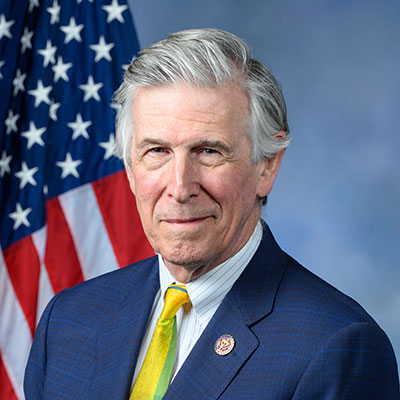Press Releases
Beyer Testifies On Natural Resources Committee Hearing On Wildlife Corridors Conservation Act
Washington,
October 17, 2019
Today, Rep. Don Beyer (D-VA) made a guest appearance in a Natural Resources Committee hearing on his bill, H.R. 2795, the Wildlife Corridors Conservation Act. His testimony, as prepared, is below (video of remarks as delivered here). The hearing is the most significant step procedural step forward to date for the bipartisan, bicameral legislation inspired by the work of Dr. E.O. Wilson, which was reintroduced earlier this year. This year the bill to protect biodiversity by providing for the creation of a national system of wildlife corridors has rapidly gained momentum in Congress. It is endorsed by hundreds of wildlife protection organizations and outdoor retailers, including the Wildlands Network, Patagonia, the National Audubon Society, Defenders of Wildlife, and the Endangered Species Coalition. BEYER: “Thank you to the Chair of the subcommittee Congressman Jared Huffman and to the Ranking Member Tom McClintock for inviting me to testify on the Wildlife Corridors Conservation Act. This bill comes at a critical moment, particularly considering the United Nations report on the accelerated species extinction rates. According to the report, one million plant and animal species are on the verge of extinction, which comes with alarming implications for human survival. In fact, more plants and animals are threatened with extinction now than any other period in human history. Scientists have found overwhelming evidence that human activities, including deforestation, overfishing, pollution and more are behind nature’s decline. We are destroying the core of our livelihood, food, health, and economy. If we do not act now, we are in grave danger. One of the greatest threats to species survival and diversity is the loss, degradation, and fragmentation of natural habitats. America’s landscapes are becoming biologically unproductive and unhealthy because native habitats have become islands and are unable to sustain vital natural processes such as dispersal, migration, genetic exchange, acquisition of resources, population stability, and climate adaptation. Many of America’s most beloved species – from the Florida panther to the pronghorn and the monarch butterfly are under threat due to fragmentation of their habitats. Climate change is causing plants to shift in elevation and location, coastal waters to warm, and coastal habitats to erode due to sea level rise and land subsidence. Conserving, restoring, and establishing new ecological connections to facilitate the shift of species are a key climate adaptation strategy. The Wildlife Corridors Conservation Act would give these species a fighting chance at survival. This bill ensures native wildlife can continue to migrate, adapt, and thrive in the face of increasing threats to their populations and habitats by granting authority to the Secretary of Interior to designate National Wildlife Corridors on federal lands. It establishes a Wildlife Movement Grant Program to fund conservation efforts and improvement projects on state and tribal lands, and those of voluntary private landowners, to encourage natural wildlife movements. The bill directs federal agencies to collaborate with states, tribes, local governments and landowners to identify and manage wildlife corridors according to the habitat needs of native species. It will also create a shared scientific wildlife connectivity database to inform decision makers as they make land management choices. Maintaining the routes animals need to move will sustain wildlife populations, support wildlife-based recreation like hunting and fishing, and avoid conflicts with businesses that depend on public land resources. Further, wildlife corridors are cost effective and promote public safety. Each year, an estimated 1.5 million large animals are killed on our roadways, costing approximately $10 billion. Wildlife road crossings, including underpasses and overpasses with fencing, have been shown to reduce wildlife collisions by an average of 85%. Wildlife Corridor protection has bipartisan support around the country and in Congress. In 2008, the U.S. Forest Service, working with the state of Wyoming, private landowners, sportsmen and conservation organizations, established the nation’s first federally designated wildlife corridor to protect a centuries old migration route for pronghorn. Today, the Path of the Pronghorn conserves one of the longest remaining terrestrial mammal migration corridors in North America. This year alone 11 states introduced, and three states, New Mexico, New Hampshire and Oregon passed wildlife corridor legislation. Wildlife Corridor Protection also has broad public support. A 2019 poll by the National Wildlife Federation showed overwhelming support for the protection of wildlife migration. And more than 84% of respondents in Colorado and New Mexico said that they would like to see increased efforts to safe guard wildlife corridors. The science is clear on the effectiveness of wildlife corridors. Over 20 years of published scientific research from 180 scientific studies have shown that maintaining habitat connectivity and corridors are key components for the survival of wildlife species. Leading scientists, including Harvard’s Dr. E.O. Wilson, stress the importance of wildlife corridor protection. A new report based on decades long research and recently published in Science Magazine finds connecting habitats has long lasting ecological effects. This legislation is a critical step forward in protecting our nation’s lands and waters and in restoring fish, wildlife, and plant populations to conserve biodiversity for future generations, especially in the face of climate change. We need this legislation now more than ever. Thank you again for inviting me to participate. |

